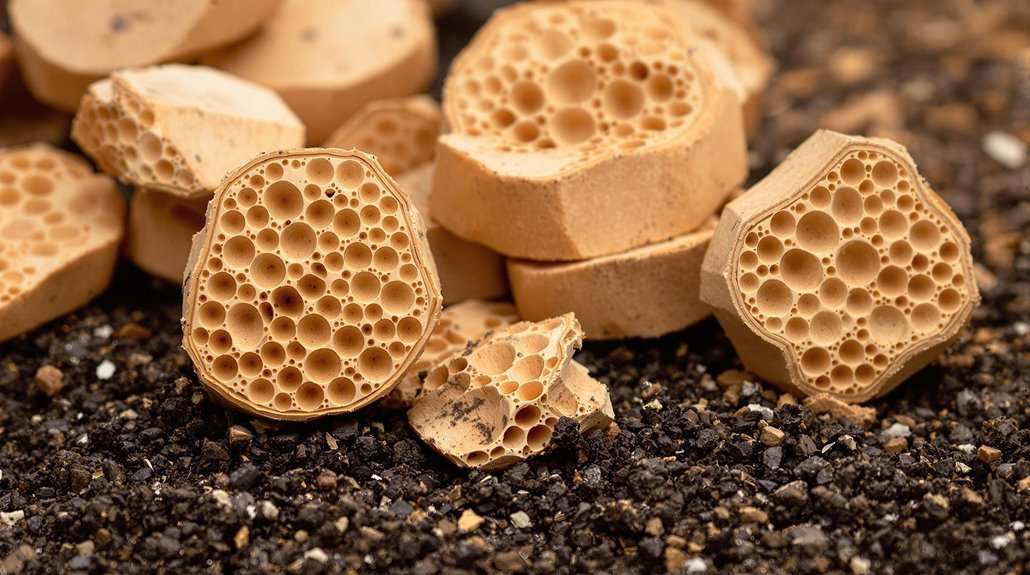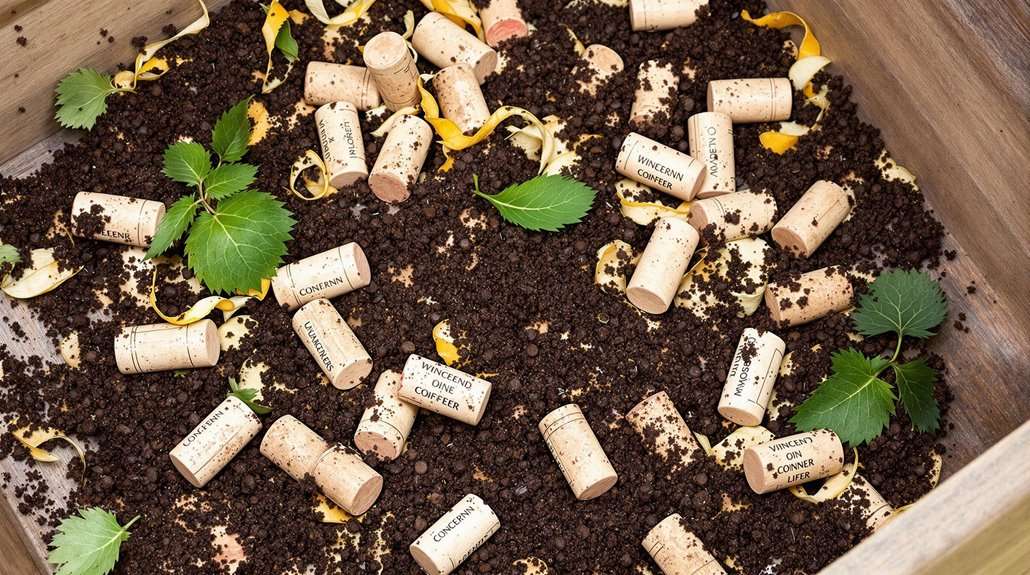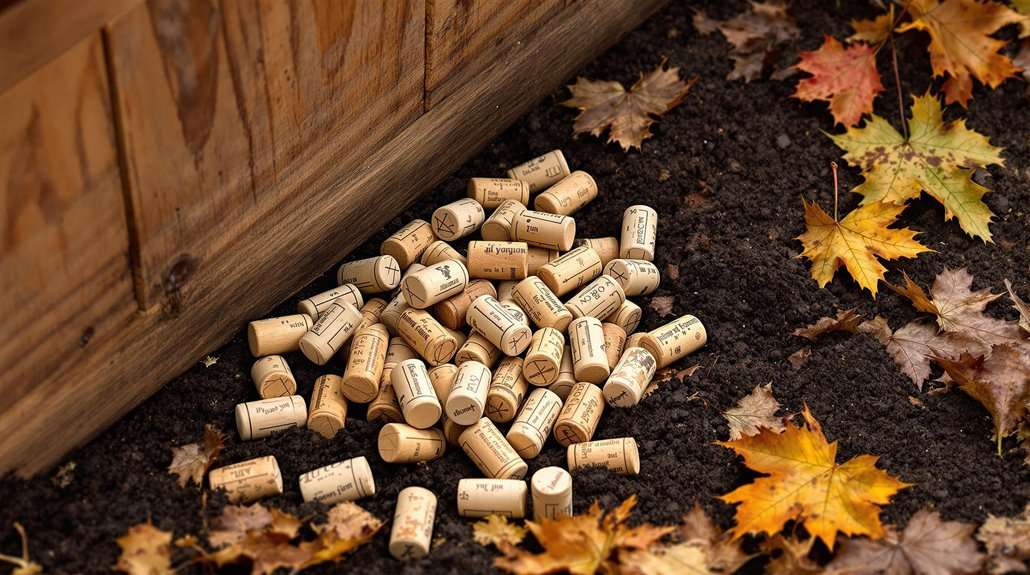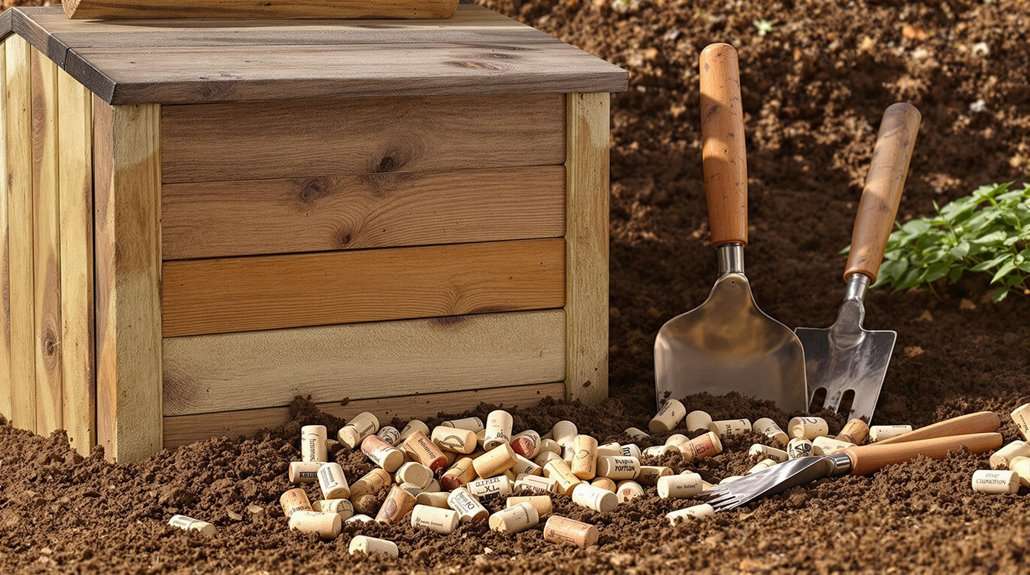Can You Compost Cork
Yes, you can compost natural cork, but not synthetic cork products. Natural cork, made from tree bark, contains biodegradable materials like suberin (40-53%) and lignin (22-26%) that break down naturally in compost conditions. To compost cork effectively, you'll need to clean it, break it into smaller pieces, and mix it with both green and brown materials in your pile while maintaining proper moisture levels. You can identify natural cork by its irregular, grainy surface and ability to float in water, unlike synthetic versions which sink and won't decompose. Understanding the right composting techniques will help you maximize cork's environmental benefits.
This post may contain affiliate links. If you make a purchase through these links, I may earn a commission at no additional cost to you. Additionally, portions of this post may be generated using artificial intelligence (AI) technology. While we strive for accuracy, please be aware that AI-generated content may not always be perfect and should be fact-checked when necessary.
The Spatula Scoops
- Natural cork is fully compostable due to its organic composition of suberin and lignin, while synthetic cork cannot be composted.
- To prepare cork for composting, clean it thoroughly, remove non-biodegradable materials, and chop it into smaller pieces.
- Cork decomposition works best in hot composting conditions between 90-140°F, with proper moisture levels and regular aeration.
- Layer cork pieces with other compost materials like greens and browns, maintaining a balance for optimal decomposition.
- Cork can take longer to break down than other materials, but accelerates when shredded and mixed with nitrogen-rich ingredients.
What Makes Cork Special

Cork stands out as one of nature's most remarkable materials thanks to its unique cellular structure and impressive physical properties. You'll find it's composed mainly of suberin (40-53%) and lignin (22-26%), arranged in pentagonal or hexagonal cells that contain air pockets. This cellular arrangement gives cork its extraordinary lightweight nature, weighing only 190 to 250 kg/m³. The cork features lenticular channels that allow gas exchange between inner tissues and the exterior environment.
When you examine cork's physical properties, you'll discover what makes it truly special. It's five times lighter than water, which explains why it won't sink, and its suberin content creates a natural waterproof barrier. You can compress cork repeatedly, and it'll bounce right back to its original shape, making it perfect for wine stoppers and other applications where elasticity matters. The material's structure also gives it impressive insulating properties, with a thermal conductivity of just 0.037-0.040 W/(mK). If you're looking for sound absorption, cork excels there too, absorbing 30-70% of sounds between 400-4000 Hz. Perhaps most remarkably, cork doesn't accumulate static electricity, which means you won't find dust clinging to cork surfaces the way it does to other materials.
Natural Vs Synthetic Cork
When you're deciding whether to compost your wine corks, you'll need to know if they're natural or synthetic, which you can determine by checking their texture and appearance – natural corks have an irregular, grainy surface while synthetic ones look uniform and plasticky. Natural cork comes from cork oak trees that can be sustainably harvested for decades without harming the tree. While natural corks can be safely composted and will break down over time to enrich your soil, synthetic corks are made from plastic materials that won't decompose and need to be recycled through specialized facilities. You'll find that each type requires different handling methods, with natural corks being ideal for your compost bin and synthetic ones better suited for recycling programs that accept plastic materials.
Identifying Cork Types
Before you start composting any wine stoppers, it's important to determine whether you're dealing with natural or synthetic cork. You can identify natural cork by its non-uniform appearance, featuring visible pores called lenticels, small cracks, and occasional imperfections like belly spots or worm holes. Natural cork also has a lower density (180-200 g/cm³) and feels more compressible when squeezed. Many wine enthusiasts prefer natural cork due to its minimal oxygen exchange properties, which aid in proper aging.
In contrast, synthetic corks have a distinctly uniform appearance and higher density (230-260 g/cm³). They're typically made from polyethylene or plant-based plastics, giving them a more consistent texture and appearance throughout. You'll notice they're harder to compress and often have a slightly artificial sheen to their surface.
If you're still unsure, try the density test by placing the cork in water. Natural corks tend to float more readily due to their lower density, while synthetic ones sink faster. You can also examine the cork's cross-section – natural corks display a cellular structure with visible variations, whereas synthetic corks show a more uniform, manufactured pattern. This distinction is significant because natural corks are biodegradable, while synthetic ones aren't suitable for composting.
Environmental Impact Differences
Understanding the environmental impact between natural and synthetic cork reveals stark differences in their ecological footprints. When you're choosing between these materials, it's essential to contemplate that natural cork production creates a negative carbon balance, with cork oak forests sequestering up to 73 tons of CO2 for each ton of cork produced. In contrast, synthetic cork relies on fossil fuels for production and contributes to plastic pollution. While natural cork can be safely added to compost piles, synthetic corks melt when exposed to heat and can release harmful chemicals into the environment.
| Environmental Factor | Natural Cork | Synthetic Cork |
|---|---|---|
| Carbon Impact | Carbon negative | Carbon positive |
| Biodegradability | Fully biodegradable | Non-biodegradable |
| Resource Type | 100% renewable | Petroleum-based |
You'll find that natural cork's environmental benefits extend beyond carbon sequestration. Cork oak forests support diverse ecosystems and endangered species, while the harvesting process doesn't harm the trees. The bark regenerates every nine years, making it a truly sustainable resource. Synthetic cork, however, can't be composted, has limited recycling options, and persists in landfills indefinitely. When you reflect on these factors, natural cork emerges as the remarkably more environmentally responsible choice, offering benefits from production through disposal.
Recycling Method Variations
Recycling methods for cork vary dramatically between natural and synthetic varieties, affecting your disposal choices. If you're working with natural cork, you'll find multiple composting options at your disposal, including hot composting, cold composting, and vermicomposting. For the best results, you'll want to prepare your natural corks by cleaning off any wine residue and breaking them into smaller pieces. Using a kitchen grater to shred the corks can significantly speed up decomposition.
When it comes to synthetic corks, you'll need to take a different approach since they can't be composted. Instead, you'll want to check with your local recycling facilities about their specific capabilities for processing synthetic cork materials. While they're not typically accepted in curbside collection, many synthetic corks can be repurposed into products like pool toys and toothbrushes through specialized recycling programs. To identify synthetic corks, look for a uniform, foamy interior texture. If you're committed to hot composting natural corks, you'll need to maintain temperatures between 90-140 degrees Fahrenheit and guarantee proper moisture levels, similar to a wrung-out sponge. For cold composting, you can simply add the prepared natural cork pieces to your pile and let nature take its course.
Steps to Compost Cork

To start composting your cork, you'll need to prepare it by removing any synthetic materials, cleaning off wine residue, and chopping it into smaller pieces for faster decomposition. Once prepared, spread the cork pieces evenly throughout your compost pile, mixing them with both green and brown materials while maintaining proper moisture levels like a damp sponge. You'll want to monitor the decomposition process regularly, which can take up to three years for whole corks, though shredded pieces will break down much faster. Using a small food processor to grind the corks will significantly accelerate their breakdown in your compost pile.
Prepare Cork for Composting
Preparing cork for composting involves four essential steps that'll guarantee efficient decomposition. First, you'll need to identify and clean natural corks, removing any non-biodegradable materials like foil, plastic seals, or stickers. Once cleaned, let them dry completely in a well-ventilated area.
| Process Step | Action Required | Expected Outcome |
|---|---|---|
| Identification | Select natural cork only | Avoid synthetic materials |
| Cleaning | Remove seals and residue | Prevent contamination |
| Size Reduction | Chop or shred cork | Speed up decomposition |
Next, you'll want to break down the corks into smaller pieces using a kitchen knife or grater. This increased surface area allows for faster decomposition and better integration with other compost materials. Don't try to compost whole corks, as they'll take considerably longer to break down. The post-industrial cork scraps generated during processing can also be added to your compost pile.
Remember that only natural corks are suitable for composting – synthetic ones should be recycled through specific programs. As you add the prepared cork pieces to your compost pile, maintain proper moisture levels (similar to a damp sponge) and turn the pile regularly to introduce oxygen. These steps promote ideal conditions for aerobic decomposition and prevent unwanted anaerobic conditions.
Add Cork to Pile
Successfully adding cork to your compost pile requires careful attention to layering and moisture balance. You'll want to distribute your chopped cork pieces evenly throughout the pile, mixing them with both green materials, like fruit scraps, and brown materials, such as dry leaves. Make sure you're maintaining a moisture level similar to a wrung-out sponge to support proper decomposition. The 50/50 mixture ratio between browns and greens is essential for optimal composting.
As you add the cork, use a pitchfork or compost aerator to thoroughly incorporate it into your existing pile. Don't cluster the cork pieces together, as this can create dense pockets that slow down decomposition. Instead, spread them out in thin layers between your nitrogen-rich green materials and carbon-rich brown materials. You'll need to monitor the pile's moisture levels carefully, adding water if it's too dry or more dry materials if it becomes too wet.
Keep turning your pile regularly to maintain proper oxygen flow and prevent anaerobic conditions. Remember to avoid adding synthetic corks, as these won't break down, and make sure you're not overwhelming your pile with too much cork at once.
Monitor Decomposition Progress
Your compost pile's progress requires consistent monitoring to guarantee cork decomposition stays on track. You'll need to regularly check several key factors to confirm ideal breakdown of your cork materials and maintain healthy composting conditions.
| Monitoring Factor | Action Required |
|---|---|
| Temperature | Check daily with thermometer; maintain 90-140°F |
| Moisture Content | Test weekly; should feel like damp sponge |
| Aeration | Turn pile every 3-5 days for oxygen flow |
| Distribution | Inspect cork spacing; prevent clumping |
When monitoring your pile, you'll want to pay particular attention to any unpleasant odors, which typically indicate poor aeration or excess moisture. If you notice your corks clumping together, break up these clusters during your regular turning routine. Keep a close eye on moisture levels by using the squeeze test – the material should release just a few drops when squeezed firmly. If you're finding that decomposition seems slow, consider reducing your cork pieces to smaller sizes and confirming they're thoroughly mixed with nitrogen-rich materials. Remember to maintain consistent temperature readings with a compost thermometer, as this is vital for efficient breakdown of the cork material.
Benefits of Cork Composting
The benefits of composting cork extend far beyond simple waste reduction. When you add cork to your compost pile, you're enhancing your soil's structure while improving its ability to retain moisture. Cork's natural properties make it an excellent addition to your garden, as it breaks down to create nutrient-rich organic matter that helps your plants thrive. Shredding the corks can significantly speed up decomposition.
You'll notice several practical advantages when using composted cork in your garden. It acts as an effective weed suppressant when used as mulch, reducing your need for chemical herbicides. The material's ability to retain moisture means you won't need to water as frequently, and it's particularly beneficial during dry spells. As cork decomposes, it encourages beneficial microbial activity in your soil, creating a healthier growing environment.
Additionally, you're supporting environmental conservation when you choose to compost cork. Cork oak harvesting promotes biodiversity and sustainable forestry practices, as these trees can be harvested multiple times throughout their lifespan. The process actually increases the trees' CO2 absorption, making cork composting an environmentally conscious choice for your garden's health and the planet's well-being.
Cork Recycling Options

While composting offers an excellent way to repurpose cork, several dedicated recycling programs provide alternative paths for your used corks. You'll find that major organizations like ReCORK and Cork Forest Conservation Alliance have established extensive collection networks, making it easier for you to dispose of natural corks responsibly. The process involves hand harvesting cork bark to ensure the highest quality materials are selected for recycling.
If you're looking for convenient drop-off locations, you can take your natural corks to Whole Foods Market stores, which partner with Cork ReHarvest to process and repurpose these materials. For synthetic corks, you'll want to use Terracycle's mail-in recycling program, as these materials require different processing methods. WIDGETCO's Cork Club program offers another option, where your recycled corks contribute to both environmental conservation and charitable giving.
Before you recycle, make sure to sort your corks properly. Natural corks have a distinctive grainy texture and compress easily, while synthetic versions typically feel smoother and more plastic-like. By choosing the right recycling program for your specific type of cork, you're contributing to a circular economy and supporting initiatives that transform these materials into new products like flooring, insulation, and footwear components.
Environmental Impact of Cork
Understanding cork's environmental footprint reveals its remarkable sustainability credentials. When you choose natural cork products, you're supporting one of nature's most sustainable materials. Cork oak trees, which can live up to 150 years, serve as powerful carbon sinks, absorbing CO2 from the atmosphere and storing it in their bark, which can be harvested every 9-12 years without harming the tree. Compared to synthetic alternatives, natural cork stoppers produce 9-24 times less emissions during production.
The environmental benefits of cork extend beyond its harvesting process. You'll find that natural cork production has a notably lower carbon footprint compared to synthetic alternatives, making it an environmentally responsible choice. Here's what makes cork particularly eco-friendly:
- Cork oak forests continue to capture carbon throughout their lifetime, even after multiple bark harvests
- The harvesting process is renewable, as the bark regenerates naturally without requiring tree removal
- Cork decomposition, when properly managed through composting, returns nutrients to the soil
When you're considering cork's environmental impact, it is essential to recognize that natural cork's biodegradability provides an additional benefit. While whole corks may take time to break down, grinding them before composting significantly speeds up their return to the soil ecosystem, supporting sustainable gardening practices and reducing landfill waste.
Cork Waste Management Solutions

Proper waste management of cork products opens up numerous sustainable disposal options for environmentally conscious consumers. You'll find that natural cork can be effectively processed through several methods, with composting being one of the most environmentally friendly approaches. A well-maintained compost pile with cork requires regular turning and aeration.
When you're managing cork waste, you'll want to start by sorting your materials carefully. If you're planning to compost, you'll need to identify and separate natural corks from synthetic ones, as the latter won't decompose. For natural corks, you can choose between hot composting, which requires maintaining specific temperature ranges between 90-140°F, or cold composting, which takes longer but requires less maintenance. You can also consider vermicomposting, where worms help break down the cork material.
If composting isn't suitable for your situation, you've got other options. You can repurpose corks as mulch around plants or use them in planters for drainage. For synthetic corks, check with your local recycling facilities, as some may accept these materials. Remember to remove any labels or coatings before processing, as these can contaminate your chosen disposal method.
Frequently Asked Questions
How Long Does Cork Take to Decompose in a Compost Bin?
Like a fallen leaf gradually returning to the earth, cork breaks down over time in your compost bin. You'll find that whole wine corks typically take up to 3 years to decompose, but you can speed up this process by shredding them first. Under ideal conditions – maintaining moisture, ensuring proper oxygen levels, and keeping temperatures between 90-140°F – your shredded cork pieces will decompose much faster, often within several months.
Can Wine-Soaked Corks Carry Harmful Bacteria Into the Compost?
While wine-soaked corks can potentially harbor bacteria, you shouldn't be overly concerned when composting them. The high temperatures in a properly maintained compost pile (130-150°F) will typically kill harmful bacteria. To minimize any risks, you can rinse and dry your corks before adding them to your pile, and guarantee you're maintaining proper composting conditions with adequate heat, moisture, and aeration.
Will Cork Attract Pests or Insects to My Compost Pile?
Like a well-sealed wine bottle, properly prepared cork won't invite unwanted guests to your compost. You'll minimize pest attraction by following key steps: clean your corks thoroughly to remove wine residue, chop them into smaller pieces, and maintain a balanced compost pile. Natural corks actually deter pests, while synthetic ones shouldn't be composted at all. Regular turning of your pile and proper moisture control will further discourage pest issues.
Does Cork Change the Ph Level of My Compost?
You don't need to worry about cork affecting your compost's pH levels, as natural cork is pH neutral. It won't disrupt the acidity or alkalinity of your compost pile when mixed with other materials. To maintain ideal pH balance, continue focusing on proper ratios of green and brown materials, guarantee good aeration, and keep appropriate moisture levels. Just remember to use natural cork, not synthetic alternatives.
Can I Add Cork Dust or Cork Granules to My Compost?
You're barking up the right tree with cork dust and granules – they're excellent additions to your compost. These smaller particles break down much faster than whole corks, increasing the surface area for microbes to work their magic. Just make sure you're using natural cork products, not synthetic ones, and mix them thoroughly with your other composting materials. They'll help create air pockets and improve your pile's structure.





